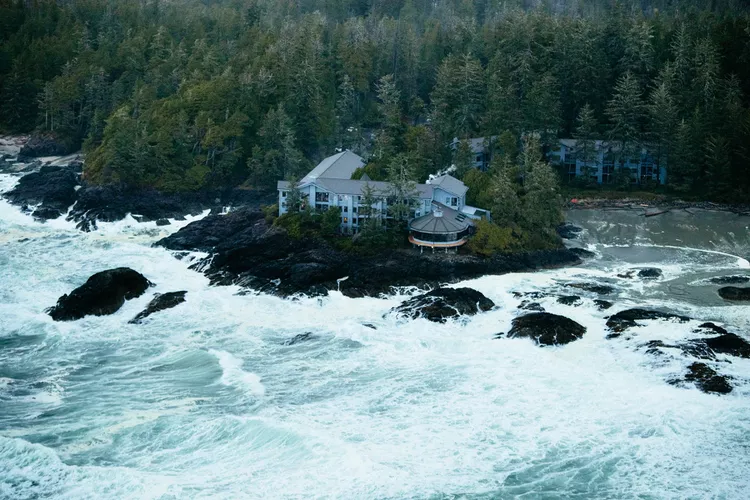Why You Should Go Stormwatching in the Pacific Northwest
- A thrilling experience draws visitors between November and February.
- Explore stunning lodges ideal for observing powerful Pacific storms.
- Learn essential safety tips for an enjoyable stormwatching adventure.
Five inches of rain was due to fall over the Washington coast in the next 48 hours, and I was headed straight into the storm. On my slow-going, three-hour drive from the Seattle airport to Copalis Beach one January night, what started as a light mist turned to heavy rain, and I had to dodge tree debris scattered in the road.
Around 9 p.m., I finally reached Iron Springs Resort. After settling into my cabin, I walked outside on the deck overlooking Boone Creek and the Pacific Ocean beyond. I felt the stinging rain on my face and could hear the crashing waves, but I couldn’t make out the landscape—it was not until morning, when I raised the window shades, that I saw the mammoth waves crashing in the distance and white-tipped pulses of water racing up the creek, propelled by the high tide. I was in no hurry to rush out the door, sitting for hours at the window, watching the infinite rolling of the water.

I’m not alone in my interest in this powerful phenomenon—each year between November and February, when Pacific storms are at their most violent, stormwatching season draws people to the coast to marvel at these tempests. In Oregon and Washington, lodges built high on oceanside bluffs allow visitors to observe from a safe vantage point. Several properties—like Headlands Coastal Lodge & Spa in Pacific City, Oregon—offer specialized stormwatching experiences.
Further north, the Wickaninnish Inn in Tofino, British Columbia, was designed specifically for stormwatching. As a child, Charles McDiarmid observed waves on Chesterman Beach from his family’s nearby cabin, inspiring him and his brother to create a stormwatching haven at the inn when they opened it in 1996.
According to McDiarmid, “You’d see 25 to 30-foot waves crashing on the rocks right in front of the cabin, and we all felt very secure in our little nest there amidst the storm.” He describes the distinctive sound of huge driftwood logs smashing into bedrock, producing a low vibration akin to a tuning fork. “It’s a front-row seat at the movie theater of Mother Nature, like an extra wide screen in high definition.”

Pacific storms are exceptionally intense due to several factors, explains Bridget Trosin, a coastal policy specialist with Washington Sea Grant at the University of Washington. “These storms barrel off the Pacific with no land breaks to dissipate the waves or the storm until it rolls right into the coast,” she notes.
Moreover, when a powerful Pacific storm coincides with a king tide—generally occurring in the winter months—they can be especially damaging. In the Pacific Northwest, king tides usually align with winter storms, as record high tides have recently caused flooding and damage in several locations.
Safety is paramount when stormwatching. Consequently, remember these essential rules:
- Stay farther back from the water than you think you need to.
- Be alert for “sneaker” or “rogue” waves that come without warning.
- Avoid standing on storm walls or breakwalls as waves can wash over them.
- Adhere to signage and guard rails.
- Never turn your back on the ocean.
Of course, if you prefer to enjoy the show from the comfort of a cozy cabin, like I did at Iron Springs, that’s an option too. Between gazing at the stormy seas, I engaged with my cabin’s collection of puzzles, books, and an extensive DVD menu, learning that the nearby Copalis Airport is the only one in Washington with a sand runway.
Doug True, who first visited the resort at age 10, now owns it with his wife Janet. They’ve expanded it from eight cabins to 25, with Doug returning to share the same spectacular storms with his grandchildren, calling it “my favorite place to come in the world.”

The following day, as the sun finally peeked out, I drove north to Kalaloch Lodge. Located on a bluff in Olympic National Park—home to 73 miles of beautiful coastline—Kalaloch offers a breathtaking viewpoint for observing the storms. From my bluff-side cabin, I heard the powerful waves below and spotted large driftwood pieces dotting the beach. I struck up a conversation with an artist painting en plein air, capturing the waves with colors reminiscent of the ocean.
Amy Neil, the lodge’s general manager, emphasized the ocean’s draw for visitors each winter, often attracting families spanning multiple generations. She recounted how a powerful storm recently battered the stairs leading to the beach, promising an exhilarating view. “The ocean is just so powerful. It’s in charge,” Neil shared.
These intense storms also invigorate the national park’s celebrated Hoh Rain Forest, roughly an hour inland from Kalaloch. The Hoh receives nearly 12 feet of rain annually, and during my sunlit visit, I appreciated the aftermath of winter storms. As I hiked the Hall of Mosses trail, my steps crunched on ice and snow beneath the majestic trees adorned with glistening moss.
On my way back, I stopped at Ruby Beach, relishing the blue skies and the joyous atmosphere shared with fellow beachgoers. This sunny respite was a stark contrast to the recent powerful storm, bringing a sense of peace after days of tempestuous weather.





